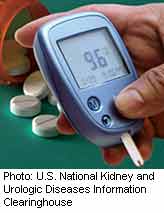Lower proportion of monomethylarsonate linked to higher incidence of diabetes
TUESDAY, March 31, 2015 (HealthDay News) — Arsenic metabolism is prospectively associated with diabetes incidence, according to a study published in the April issue of Diabetes Care.
Chin-Chi Kuo, M.D., M.P.H., from the Johns Hopkins Bloomberg School of Public Health in Baltimore, and colleagues examined the prospective association between low-moderate arsenic exposure and arsenic metabolism with diabetes incidence. The investigators recruited 1,694 diabetes-free participants aged 45 to 75 years in 1989 to 1991 and followed them through 1998 to 1999. The proportions of urine inorganic arsenic (iAs), monomethylarsonate (MMA), and dimethylarsinate (DMA) over their sum (expressed as iAs percent, MMA percent, and DMA percent) were used as arsenic metabolism biomarkers.
The researchers found that 396 participants developed diabetes over 11,263.2 person-years of follow-up. Modeling the dynamics of arsenic metabolism with the leave-one-out approach, lower MMA percent correlated with higher incidence of diabetes. When iAs percent and DMA percent were left out of the model, a 5 percent increase in MMA percent correlated with a hazard ratio of 0.77 and 0.82, respectively. When MMA percent decreased, but not when iAs percent decreased, DMA percent correlated with higher diabetes incidence. When MMA percent decreased, iAs percent also correlated with higher diabetes incidence. The correlation between MMA percent and diabetes was independent of age, sex, study site, obesity, and urine iAs concentrations.
“Research is needed to evaluate whether arsenic metabolism is related to diabetes incidence per se or through its close connections with one-carbon metabolism,” the authors write.
Copyright © 2015 HealthDay. All rights reserved.








